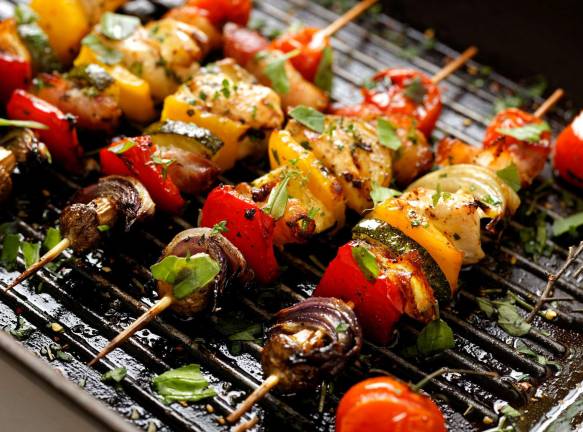Four steps toward healthier grilling

'Tis the season of the backyard barbecue, a great way to enjoy tasty outdoor meals. However, research has found that two harmful chemicals can form during grilling:
Heterocyclic amines form when proteins (amino acids and creatine) found in meat are cooked over high heat, such as grilling or broiling.
Polycyclic aromatic hydrocarbons (PAHs) form when fat and juices from meat drip down to the heat source of the grill, resulting in smoke. The smoke contains PAHs. As the smoke rises up past the food, the PAH compounds can be deposited on the surface of the meat.
In 2007, The World Cancer Research Fund recommended that people avoid eating burned or charred foods frequently or in large quantities. And that makes sense, because studies suggest a link between eating a lot of overcooked, fried, and grilled meats and certain types of cancer.
Step oneMake veggies the main attraction. Kebabs are a great way to increase vegetable intake. Try skewers of colorful bell peppers, onions, and small pieces of chicken or lean meat. Smaller pieces of meat take less time on the grill. You can add fruit (such as pineapple, papaya, and/or mango) to skewers, too.
Step twoIf you’re grilling meat, prep it first. Trim all visible fat. If you’re grilling chicken, remove the skin before cooking. Visible fat chars easily, especially when flames “lick” the food. Marinate fish and chicken. Marinades cut down on the smoke that sticks to the surface of the meat. Thin marinades are best, especially if they contain vinegar and/or lemon. Thicker, commercially prepared marinades have more of a tendency to char, possibly increasing exposure to carcinogenic compounds. If you’re using a marinade that contains honey, sugar, or tomato products, apply it in the last minute or two of grilling to avoid burning or charring.
Step threeLimit the time food is on the grill. Precook meat in the microwave on high for 60 to 90 seconds, then discard the juices. Less juice will drip down to the heat source, which is the source of PAHs. You’ll also cut down on cooking time, thereby reducing potential exposure to chemicals formed in the grilling process. Don’t grill frozen meat; thaw it first to reduce the amount of time needed to cook it. Avoid charring or overcooking meats. Cut off and throw away any parts that become charred.
Step fourKeep smoke to a minimum because that’s where PAHs are concentrated. Avoid “smashing” or flattening burgers while they are cooking on the grill. This leads to higher levels of dripping juices and more unwanted smoke. Grill burgers at a lower heat and flip them once per minute until cooked. Researchers at Livermore National Laboratory in California determined that frequent flipping prevents juices from dripping down to the heat surface, leading to less smoke. In addition:
Food should be at least six inches from the heat source — more if possible.
Grill fish and chicken on top of a piece of aluminum foil that has a few small holes. This barrier will keep juices from dripping down and creating additional smoke.
Other safety tips Paying attention to how you cook meat is important, but there are other ways to make grilling safer.
Keep uncooked meat, poultry, and seafood separate from vegetables and other foods. The USDA has other tips for safe food preparation.
Keep your grill bristle-free. While it’s uncommon, there have been reports of internal injury following accidental consumption of stray grill cleaning bristles. Replace your grill cleaning brush each year, and after you use a brush to clean the grill rack, wipe it down with a towel.
Source: Harvard Medical School: health.harvard.edu